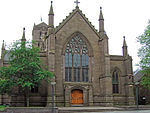V&A Dundee
2018 establishments in ScotlandArt museums and galleries in ScotlandDesign museumsKengo Kuma buildingsMuseums established in 2018 ... and 2 more
Museums in DundeeVictoria and Albert Museum

V&A Dundee is a design museum in Dundee, Scotland, which opened on 15 September 2018. The V&A Dundee is the first design museum in Scotland and the first Victoria and Albert museum outside London. The V&A Dundee is also the first building in the United Kingdom designed by Kengo Kuma.
Excerpt from the Wikipedia article V&A Dundee (License: CC BY-SA 3.0, Authors, Images).V&A Dundee
Riverside Esplanade, Dundee Waterfront
Geographical coordinates (GPS) Address Phone number Website External links Nearby Places Show on map
Geographical coordinates (GPS)
| Latitude | Longitude |
|---|---|
| N 56.457472222222 ° | E -2.9672222222222 ° |
Address
V&A Dundee
Riverside Esplanade 1
DD1 4EZ Dundee, Waterfront
Scotland, United Kingdom
Open on Google Maps








